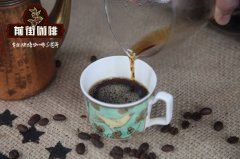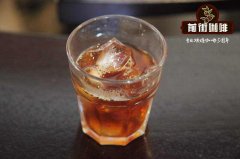Mixed coffee made by hand in autumn | coffee beans made by hand [Ethiopian washing Cochel]

Professional coffee knowledge exchange more coffee bean information please follow the coffee workshop (Wechat official account cafe_style)
Autumn hand-mixed coffee | A brief introduction to hand-made coffee beans [Ethiopian washing Cochel]? What are the flavor characteristics?
Cochel is located in Yega Sheffield, Ethiopia. The grades of washed raw beans are G1 and G2, and those of sun-dried beans are G3, G4 and G5. The coffee flavor of Cochel G1 has bright sour fruit and slightly sweet fruit, with the flavor and aroma of the producing area. Due to the obstruction of the Great Rift Valley in East Africa, the types of coffee beans on the two half walls are different, the eastern half of Hara variety → has the difference between long body and short body, and the varieties of the western half wall primeval forest are numerous and complex, and the beans of Irubabo, Tana Lake and Jinbi in the northwest are obviously stronger. Coffee farmers in the Hara Heights in the east and the Kafa forest in the southwest have a bright plot, and farmers in the east claim that Arabica comes from the Hara Heights, not the Kafa forest in the southwest. Kafa Forest: Jinma, Tiebi and Bebeca have higher disease resistance, but the flavor is inferior to the eastern half.
Cochell producing area (Kochere):
Above sea level 1900 Murray 2000 meters | Pastoral coffee system
Cochel is located in a small producing area 25 kilometers southeast of Yegashafi, Ethiopia. It is an area that produces coffee and is rich. It is also one of the three famous and micro-producing areas of Yegashafi. It has about 100,000 local residents, and coffee beans are the main source of income. The processing and processing equipment of this production area is very advanced. Coffee Review, a well-known coffee evaluation website, gave Kocher a high rating of 94 points for washed beans.
Flavor: plum citrus aroma is obvious, fruit acid is more balanced and not irritating, the taste is transformed into sweet taste, the latter part has a touch of cocoa mellow, suitable for people who like refreshing taste.
The cultivation system is the most diverse
Forest Coffee (Forest coffee)
Refers to wild coffee trees in the primeval forest. Protected by the government, there are special personnel to harvest. The total output is only 10% of 5m / m.
Half Forest Coffee (Semi-forest coffee)
Refers to semi-wild coffee, farmers regularly go to the forest to trim shade trees or coffee branches and leaves to increase light transmittance and fruit yield. The total output accounts for 35%.
Rural Coffee (Garden coffee)
Refers to small farmers grow their own, mixed with other cash crops, mostly under the elephant legs. The total output accounts for 50%.
Planting Coffee (Plantation coffee)
The state-owned or private development of land is similar to the entrepreneurial and scientific management in Central and South America. The total output accounts for only 10% of 5muri.
Yega Xuefei (Yirgacheffe): 1800 Murray 2000m above sea level | Pastoral coffee system
Yega Xuefei is very popular with the international community:
Treatment: washing is the main method.
After 1970, the unique floral aroma and citrus flavor of washed Yejia Xuefei became popular all over the world, which was known as "Yejia Xuefei flavor". In 2003, a chemist, Dr. Yili (the late), pointed out in a speech at the American boutique association that some of the aroma components of Yega Xuefei can also be found in Chanel No. 5 perfume and Darjeeling tea, known as Darjeeling black champagne.
But since 2006, the sun treatment blew the horn of counter-attack, and the sun beans were killed and washed in the "Gold Cooperative Coffee Competition" (Gold Cooperative Coffee Competition), and the top three high scores were all covered by sun beans. Coffee trader Adulabaghi buys certain varieties of ripe extra red fruits from small farmers in MistValley, the highest altitude in Yega, and concentrates them on the tanning factory it runs in the small town of Idido. Yejia Xuefei sun-dried beans treated by strict quality control have repeatedly bloomed in the category of boutique coffee and become famous products that gluttons scramble to taste.
Sun-dried beans taste: sour, thicker, better consistency, larger amplitude.
Washed beans taste: floral fragrance and cleanliness
Ethiopian coffee beans are graded according to the number of defective beans, which are divided into 5 grades:
G1--G2 for washed beans: G1 is the most advanced, no more than 3 defective beans per 300g raw beans.
G3--G5 is sun beans: G5 is the lowest level for Ethiopian coffee exports.
Qianjie cuisine is recommended:
Filter cup: Hario V60
Water temperature: 90 degrees
Degree of grinding: small Fuji 3.5
Cooking methods: the ratio of water to powder is 1:15, 15g powder, the first injection of 25g water, 25 s steaming, the second injection to 120g water cut off, waiting for the powder bed water to half and then water injection, slow water injection until 225g water, extraction time about 2:00
Analysis: using three-stage brewing to clarify the flavor of the front, middle and back of the coffee. Because the V60 has many ribs and the drainage speed is fast, it can prolong the extraction time when the water is cut off.
Important Notice :
前街咖啡 FrontStreet Coffee has moved to new addredd:
FrontStreet Coffee Address: 315,Donghua East Road,GuangZhou
Tel:020 38364473
- Prev

French Missionary Bourbon Coffee Bean Missionary Bourbon Coffee Features Missionary Bourbon Coffee
Professional coffee knowledge exchange More coffee bean information Please pay attention to coffee workshop (Weixin Official Accounts cafe_style) Love to drink strong fruit acid flavor, you can choose African sun beans, such as Kenya's French missionary bourbon species. Kenya coffee has a unique flavor, with natural fruit acids, full-bodied blackberry flavor, and strong wine aroma, taste bold and full of tropical flavor
- Next

Can hand-brewed coffee beans be called mixed coffee? What does it mean to make coffee by hand? Such as
Professional coffee knowledge exchange more coffee bean information please follow the coffee workshop (Wechat official account cafe_style) hand-brewed coffee beans can be called mixed coffee? What does it mean to make coffee by hand? How to mix beans with boiled hands? Generally speaking, hand-mixed beans will use a key point to reconcile the taste, aroma and taste. From sweet, bitter or sour coffee
Related
- Detailed explanation of Jadeite planting Land in Panamanian Jadeite Manor introduction to the grading system of Jadeite competitive bidding, Red bid, Green bid and Rose Summer
- Story of Coffee planting in Brenka region of Costa Rica Stonehenge Manor anaerobic heavy honey treatment of flavor mouth
- What's on the barrel of Blue Mountain Coffee beans?
- Can American coffee also pull flowers? How to use hot American style to pull out a good-looking pattern?
- Can you make a cold extract with coffee beans? What is the right proportion for cold-extracted coffee formula?
- Indonesian PWN Gold Mandrine Coffee Origin Features Flavor How to Chong? Mandolin coffee is American.
- A brief introduction to the flavor characteristics of Brazilian yellow bourbon coffee beans
- What is the effect of different water quality on the flavor of cold-extracted coffee? What kind of water is best for brewing coffee?
- Why do you think of Rose Summer whenever you mention Panamanian coffee?
- Introduction to the characteristics of authentic blue mountain coffee bean producing areas? What is the CIB Coffee Authority in Jamaica?

